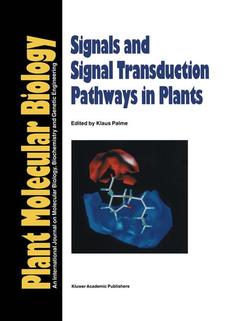Description
Signals and Signal Transduction Pathways in Plants, 1994
Coordinator: Palme Klaus
Language: English
Subject for Signals and Signal Transduction Pathways in Plants:
Publication date: 10-2012
452 p. · 21x28 cm · Paperback
452 p. · 21x28 cm · Paperback
Description
/li>Contents
/li>Comment
/li>
Plants offer exciting opportunities to understand major biological questions, i.e. the regulation of development and morphogenesis. How are changes of the environment, developmental cues, and other signals perceived and transduced in physiological responses? What are the elements of plant signalling pathways and what is their organization? The panoply of molecular tools and techniques as well as the blossoming field of plant genetics are providing an exciting ground for major breakthroughs in unravelling the fundamental mechanisms of plant signalling. The present book establishes a state-of-the-art framework spanning the wide spectrum of perception, signal transduction events and transport processes, including cell proliferation and cell cycle regulation, embryogenesis, and flowering. Moreover, the volume emphasizes the role of the major plant signalling substances known to date (the phytohormones and more recently studied substances) and summarizes what we know on their molecular mechanisms of action. The book emphasizes how the use of molecular technology has made plant signalling processes accessible to experimental test.
Transmembrane signalling in eukaryotes: a comparison between higher and lower Eukaryotes.- Signal transduction in the sexual life of Chlamydomonas.- Control of cell proliferation during plant development.- Signal molecules involved in plant embryogenesis.- Initial events in phytochrome signalling: still in the dark.- Mechanical signalling, calcium and plant form.- Plasmodesmata: composition, structure and trafficking.- Genetic analyses of signalling in flower development using Arabidopsis.- Oligosaccharins: structures and signal transduction.- Role of rhizobial lipo-chitin oligosaccharide signal molecules in root nodule organogenesis.- Fatty acid signalling in plants and their associated microorganisms.- The salicylic acid signal in plants.- Plant hormone conjugation.- Cytokinin metabolism: implications for regulation of plant growth and development.- Molecular genetics of auxin and cytokinin.- Activation tagging: a means of isolating genes implicated as playing a role in plant growth and development.- Gibberellins: perception, transduction and responses.- Current advances in abscisic acid action and signalling.- Ethylene biosynthesis and action: a case of conservation.- Structure and function of the receptor-like protein kinases of higher plants.- GTP-binding proteins in plants: new members of an old family.- Green circuits — The potential of plant specific ion channels.- Transporters for nitrogenous compounds in plants.- Sugar transport across the plasma membranes of higher plants.
'The book is an excellent overview of the many kinds of singalling processes in plants. It is of high interest to established plant scientists and also to graduate students, and will stimulate new research to further reveal the remaining secrets in the signalling pathways of plants. The book can be recommended to all plant biologists and should be present in the book shelves of general libraries and plant biology institutions. Many plant physiologists will find it useful to possess a personal copy.'Journal of Plant Physiology, 147 (1995)'...this book is very worthwile reading in order to keep up with new developments in the field of plant physiology and to translate it to applicable knowledge in horticulture and agriculture.'Scientia Horticulturae, 68 (1997)
© 2024 LAVOISIER S.A.S.




